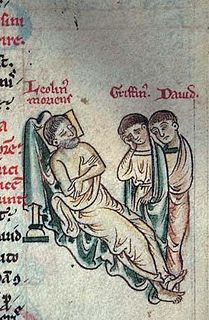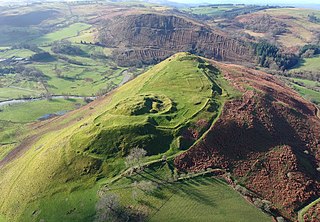Related Research Articles

Rhys ap Gruffydd, commonly known as The Lord Rhys, in Welsh Yr Arglwydd Rhys was the ruler of the Welsh kingdom of Deheubarth in south Wales from 1155 to 1197. It was believed that he usually used the title "Proprietary Prince of Deheubarth" or "Prince of South Wales"; however, two documents have been discovered in which he uses the title "Prince of Wales" or "Prince of the Welsh". Rhys was one of the most successful and powerful Welsh leaders of the Middle Ages, and after the death of the king of Gwynedd, Owain Gwynedd in 1170, he was the dominant power in Wales.

Llywelyn the Great, full name Llywelyn mab Iorwerth), was a King of Gwynedd in north Wales and eventually ruler of all Wales. By a combination of war and diplomacy he dominated Wales for 45 years.
Owain ap Gruffudd was King of Gwynedd, North Wales, from 1137 until his death in 1170, succeeding his father Gruffudd ap Cynan. He was called Owain the Great and the first to be styled "Prince of Wales". He is considered to be the most successful of all the North Welsh princes prior to his grandson, Llywelyn the Great. He became known as Owain Gwynedd to distinguish him from the contemporary king of Powys Wenwynwyn, Owain ap Gruffydd ap Maredudd, who became known as Owain Cyfeiliog.

The Kingdom of Gwynedd was a Welsh kingdom and a Roman Empire successor state that emerged in sub-Roman Britain in the 5th century during the Anglo-Saxon settlement of Britain.

The Kingdom of Powys was a Welsh successor state, petty kingdom and principality that emerged during the Middle Ages following the end of Roman rule in Britain. It very roughly covered the northern two-thirds of the modern county of Powys and part of today's English West Midlands. More precisely, and based on the Romano-British tribal lands of the Ordovices in the west and the Cornovii in the east, its boundaries originally extended from the Cambrian Mountains in the west to include the modern West Midlands region of England in the east. The fertile river valleys of the Severn and Tern are found here, and this region is referred to in later Welsh literature as "the Paradise of Powys".
Maelgwn ap Rhys was prince of part of the kingdom of Deheubarth in south west Wales.

Cefnllys Castle was a medieval spur castle in Radnorshire, Wales. Two successive masonry castles were built on a ridge above the River Ithon known as Castle Bank in the thirteenth century, replacing a wooden motte-and-bailey castle constructed by the Normans nearby. Controlling several communication routes into the highlands of Mid Wales, the castles were strategically important within the Welsh Marches during the High Middle Ages. As the seat of the fiercely contested lordship and cantref of Maelienydd, Cefnllys became a source of friction between Llywelyn ap Gruffudd and Roger Mortimer in the prelude to Edward I's conquest of Wales (1277–1283). Cefnllys was also the site of a borough and medieval town.
Bleddyn ap Cynfyn, sometimes spelled Blethyn, was an 11th-century Welsh king. Harold Godwinson and Tostig Godwinson installed him and his brother, Rhiwallon, as the co-rulers of Gwynedd on his father's death in 1063, during their destruction of the kingdom of Bleddyn's half-brother, Gruffydd ap Llywelyn. He became king of Powys and co-ruler of the Kingdom of Powys with his brother Rhiwallon from 1063 to 1075. His descendants continued to rule Powys as the House of Mathrafal.
Madog ap Llywelyn was the leader of the Welsh revolt of 1294–95 against English rule. The revolt was surpassed in longevity only by the revolt of Owain Glyndŵr in the 15th century. Madog belonged to a junior branch of the House of Aberffraw and was a distant relation of Llywelyn ap Gruffudd, the last recognised native Prince of Wales.

Powys Fadog was the northern portion of the former princely realm of Powys, which split in two following the death of Madog ap Maredudd in 1160. The realm was divided under Welsh law, with Madog's nephew Owain Cyfeiliog inheriting the south and his son Gruffydd Maelor I, who inherited the north.

Rhys Gryg, real name Rhys ap Rhys, also known as Rhys Fychan was a Welsh prince who ruled part of the Kingdom of Deheubarth.

Maelienydd, sometimes spelt Maeliennydd, was a cantref and lordship in east central Wales covering the area from the River Teme to Radnor Forest and the area around Llandrindod Wells. The area, which is mainly upland, is now in Powys. During the Middle Ages it was part of the region known as Rhwng Gwy a Hafren and its administrative centre was at Cefnllys Castle.
The Welsh uprising of 1211 was a rebellion by several Welsh princes, orchestrated by Llywelyn ap Iorwerth with primary support from Gwenwynwyn of Powys, Maelgwn ap Rhys, Madog ap Gruffydd Maelor and Maredudd ap Robert against King John of England. Although technically defeated, this uprising resulted in increased independence from England for the Welsh.
This article is about the particular significance of the century 1201–1300 to Wales and its people.

Wales in the Middle Ages covers the history of the country that is now called Wales, from the departure of the Romans in the early fifth century, until the annexation of Wales into the Kingdom of England in the early sixteenth century.
Cadwallon ap Madog was the son of Madog ab Idnerth who had died in 1140, while Idnerth was a grandson of Elystan Glodrydd who had died in around 1010 and had founded a dynasty in the Middle Marches of Wales, in the area known as Rhwng Gwy a Hafren.

Elfael was one of a number of Welsh cantrefi occupying the region between the River Wye and river Severn, known as Rhwng Gwy a Hafren, in the early Middle Ages. It was divided into two commotes, Is Mynydd and Uwch Mynydd, separated by the chain of hills above Aberedw. In the late medieval period, it was a marcher lordship. However, after the Laws in Wales Act of 1535, it was one of the territorial units which went to make up the county of Radnorshire in 1536.

Dafydd ap Llywelyn was Prince of Gwynedd from 1240 to 1246. He was the first ruler to claim the title Prince of Wales.
Maelgwn ap Rhys was a rebel and descendant of Maelgwn ap Rhys ap Gruffydd. HIs father was Rhys Fychan, Geneu'r Glyn's last lord. On 29 September 1294, Madog ap Llywelyn led a national revolt against King Edward's royal administration in north and west Wales. While Madog rebelled in the North, Maelgwn ap Rhys led the revolt in Ceredigion. Maelgwn attempted a siege of Llanbadarn but was unsuccessful. His campaign also involved heavy raids in Pembroke and Carmarthen, until the earl of Gloucester's men killed Maelgwn in 1295 in a fight near Carmarthen. Maelgwn had two brothers, Rhys and Gruffydd, both of whom were imprisoned in Norwich until as late as 1308.
References
- Thomas Jones (ed.), Brut Y Tywysogyon or Chronicle of the Princes (Peniarth Ms. 20 Version) (Cardiff, 1952).